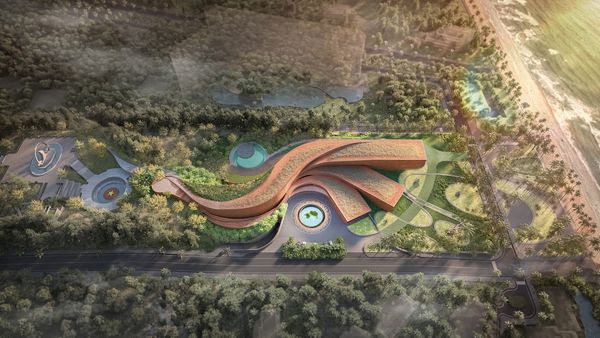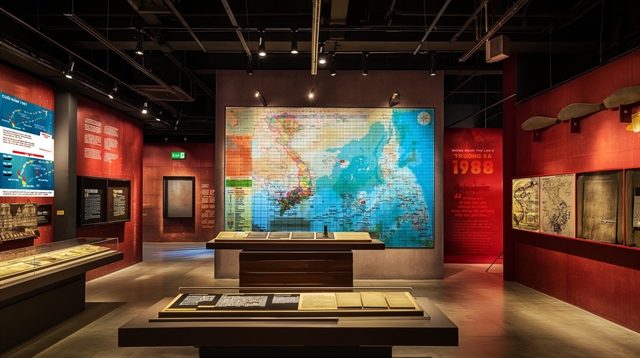Construction of Trường Sa Museum set to begin
Culture - Ngày đăng : 11:54, 20/10/2024
 |
| A design of the Trường Sa Museum by Huni Architectes company. Khánh Hòa south-central province plans to commence construction of the museum in Cam Lâm district by the end of 2024. Photo courtesy of Huni Architectes |
KHÁNH HÒA – Construction on the Trường Sa Museum project will begin by the end of the year, according to an announcement from Chief of the secretariat of the Khánh Hòa Provincial People’s Committee Nguyễn Thanh Hà.
The museum will be built on an area of 1.7ha at the boundary of the Gạc Ma Memorial Site in Cam Lâm District, where 64 naval soldiers are commemorated for bravely sacrificing their lives to defend the Gạc Ma (Johnson South), Cô Lin (Collins) and Len Đao (Landsdowne) reefs in Việt Nam’s Trường Sa (Spratly) Archipelago on March 14, 1988.
Hà made the statement at a recent press conference in the south-central province, stating that the architectural plan for the museum has been selected and the rest of the design process will be completed rapidly so construction can begin in the near future.
He said the museum will sit on uphill terrain and face towards the sea. Construction is part of the second phase of the overall Gạc Ma Memorial Site project that was launched by the Việt Nam General Confederation of Labour in 2017 with an estimated fund of VNĐ130 billion (US$5.2 million).
At the press conference, the chief of the secretariat also confirmed the construction plan for the Dr Alexandre Yersin Museum on 5.872sq.m at Trần Phú Street.
He said the Dr Yersin Museum will be located on the land previously occupied by Guest House No. T378 of the Khánh Hòa Provincial Public Security department.
The land clearance and hand-over has already been completed so construction can commence soon, according to Hà.
 |
| A digital design of an interior section of the Trường Sa Museum. The museum will be built in Cam Lâm district of Khánh Hòa Province. Photo courtesy of Huni Architectes |
Dr Yersin, who spent much of his working life in Khánh Hòa Province's Nha Trang City, is best remembered as the co-discoverer of the bacillus responsible for the bubonic plague and for creating an anti-serum, which was later named in his honour: Yersinia pestis.
He also founded the largest medical school in Việt Nam in 1902, serving as its director for the first two years.
The province also agreed to reschedule the construction of Khánh Hòa Museum under the 2026-30 plan, as the provincial agencies are still selecting an appropriate location as well as design.
Hà added that only two projects – the Trường Sa Museum and Dr Yersin Museum – have been approved for construction this year.
The Trường Sa Museum will display documents and exhibits related to the country’s sovereignty at sea and on islands, and will serve as a destination as well as an educational site for communities and young generations to learn about the nation’s history and protection of the sea and islands in the past.
The museum is one of many different parts of the Gạc Ma Memorial Site, which honours 64 martyrs who fought to protect Việt Nam's Gạc Ma (Johnson South) Reef in 1988 and helped develop the country's Trường Sa (Spratly) Archipelago.
March 14 is an annual event honouring the martyrs and their families as well as veterans who helped create a historical landmark for the Vietnamese navy to commemorate the protection of the country’s islands and sea.
 |
| A monument of the Gạc Ma Memorial Site in Cam Lâm district of Khánh Hòa Province. The site is a place to commemorate 64 naval soldiers who bravely sacrificed their lives to defend the Gạc Ma (Johnson South), Cô Lin (Collins) and Len Đao (Landsdowne) reefs in Việt Nam’s Trường Sa (Spratly) on March 14, 1988. Photo courtesy of Lê Lâm |
Sixty-four engineers were killed, 11 wounded and nine imprisoned by the Chinese navy. Two unarmed Vietnamese cargo ships were sunk in the fight to protect Cô Lin (Collins Reef, or Johnson Reef North), Len Đao (Landsdowne) Reef and Gạc Ma Reef (Johnson South), all part of the Trường Sa (Spratly) Archipelago, in 1988.
The Gạc Ma Reef was illegally occupied by Chinese invaders later in 1988.
Many martyrs killed in the fight were laid to rest at sea.
Numerous artefacts and documents on Việt Nam’s sovereignty over the Hoàng Sa (Paracel) and Trường Sa (Spratly) Archipelagos are on display at museums nationwide.
The Trường Sa (Spratly) Archipelagos in Khánh Hòa Province and Hoàng Sa (Paracel) Islands near Đà Nẵng City belong to Việt Nam, which has held sovereignty over these areas despite incursions from the Chinese.
The Hoàng Sa (Paracel) Museum in Đà Nẵng – a landmark and the largest store of legal evidence, documents and old map collections about the Trường Sa and Hoàng Sa archipelagos – has been recognised as a destination for tourists.
Historical researcher Võ Hà released the book Trường Sa 1988 – Hồ Sơ Một Sự Kiện Lịch Sử (Trường Sa 1988 – A Dossier on a Historical Incident) focusing on the protection of Gạc Ma (Johnson), Colin and Len Đao reefs in Việt Nam’s Trường Sa Islands against the 1988 Chinese invasion.
The book highlights the strong will and spirit of the Vietnamese people in protecting the country’s sovereignty over the Trường Sa and Hoàng Sa, which Việt Nam has managed from the 17th to the 19th century up through today.
Hà wrote: "China illegally occupied some parts of the Trường Sa Islands between 1976 and 1988, and the fight on the Gạc Ma (Johnson) reef was an outbreak of the 22-year-invasion by China of Việt Nam’s islands and seas.”
"In 1974, China invaded west of the Paracels and illegally occupied the entire Hoàng Sa Island under management of the Republic of Việt Nam, or the Sài Gòn administration.”
The musical Trường Sa – Bến bờ trong nhau (Trường Sa - A Shore in Each Other) showcases previously unseen footage of the Trường Sa Archipelago and was released by the Arts Division of Việt Nam Television (VTV). VNS
